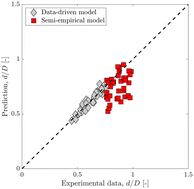Surfactant-laden droplet size prediction in a flow-focusing microchannel: a data-driven approach†
Abstract
The control of droplet formation and size using microfluidic devices is a critical operation for both laboratory and industrial applications, e.g. in micro-dosage. Surfactants can be added to improve the stability and control the size of the droplets by modifying their interfacial properties. In this study, a large-scale data set of droplet size was obtained from high-speed imaging experiments conducted on a flow-focusing microchannel where aqueous surfactant-laden droplets were generated in silicone oil. Three types of surfactants were used including anionic, cationic and non-ionic at concentrations below and above the critical micelle concentration (CMC). To predict the final droplet size as a function of flow rates, surfactant type and concentration of surfactant, two data-driven models were built. Using a Bayesian regularised artificial neural network and XGBoost, these models were initially based on four inputs (flow rates of the two phases, interfacial tension at equilibrium and the normalised surfactant concentration). The mean absolute percentage errors (MAPE) show that data-driven models are more accurate (MAPE = 3.9%) compared to semi-empirical models (MAPE = 11.4%). To overcome experimental difficulties in acquiring accurate interfacial tension values under some conditions, both models were also trained with reduced inputs by removing the interfacial tension. The results show again a very good prediction of the droplet diameter. Finally, over 10 000 synthetic data were generated, based on the initial data set, with a Variational Autoencoder (VAE). The high-fidelity of the extended synthetic data set highlights that this method can be a quick and low-cost alternative to study microdroplet formation in future lab on a chip applications, where experimental data may not be readily available.

- This article is part of the themed collection: AI in Microfluidics


 Please wait while we load your content...
Please wait while we load your content...